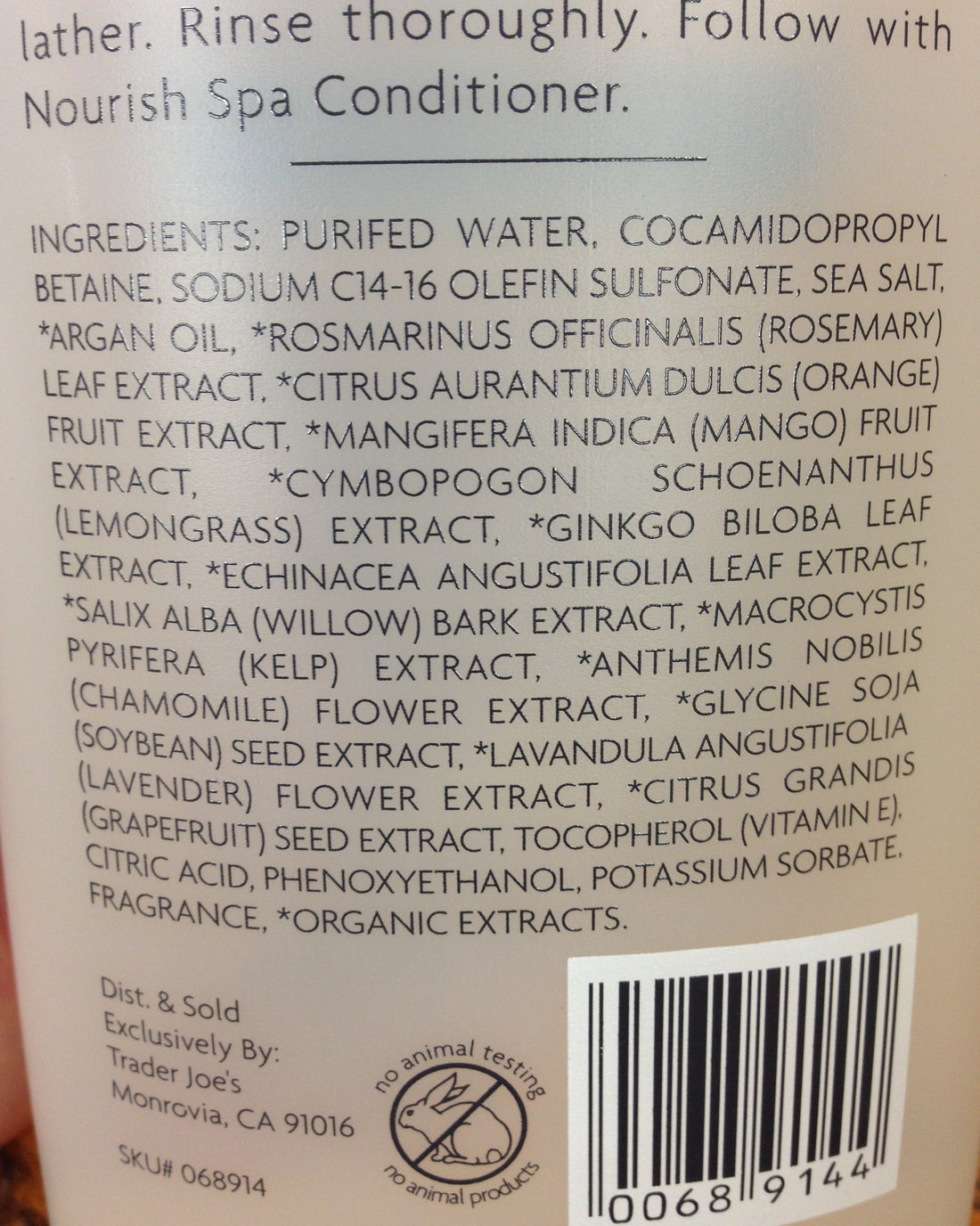
Why I Don't Buy Trader Joe's Soaps Right Now
Note: We love Trader Joe's and shop there all the time. The store is awesome and the people are great. (No, they're not paying us to say this!) But we don't buy the soaps they sell right now. Read below to find out why.
Recently, I was in my favorite store (Trader Joe’s, love them!) and did a little snooping around in their soaps department. I was kind of shocked when I looked at the list of ingredients in their soaps.
"Trader Jacques" Savon de France Ginger Almond Oatmeal Exfoliant Bar

From my viewpoint, there’s only one Trader Joe’s-branded soap that probably doesn’t have harsh ingredients: their Ginger Almond Oatmeal Exfoliant bar soap marketed under their “Trader Jacques” Savon de France label. However, I don’t know what fragrance they’re using (they’re not required to specify that on the label), and they don’t list their complete ingredients list.
Ingredients: “Contains: pure vegetable oils (olive, palm, and coconut oils, oatmeal, fragrances and/or essential oils.”
Interestingly, they don’t list sodium hydroxide (lye) which is a key ingredient for making this kind of soap. Probably a label typo – a significant omission, since it’s a necessary ingredient. Maybe it’s not a complete list of ingredients? Not sure. I didn’t see ingredients listed elsewhere on the label.
Just because it's not on the label doesn't mean it wasn't used in processing. The biggest issue with this label is it doesn't list the processed version of things either. It just lists a list of oils, and clearly a lump of oils won't clean or lather. So it has omitted part of the ingredients.
So, here’s a roundup of the OTHER soaps I found on the shelf, and what’s in them.
Trader Joe’s Next to Godliness Oatmeal & Honey Soap Pure Vegetable


Ingredients: Sodium Palmitate, Sodium Palm Kernelate, Water, Glycerin, Essence of Oatmeal, Oatmeal Flakes, Honey, Sodium Chloride, Pentasodium Pentetate.
(In case you're wondering "where's the sodium hydroxide?" -- let me explain. "Sodium Palmitate" means "Palm Oil that's been mixed with Sodium Hydroxide and is now soap." Similarly, "Sodium Palm Kernelate" means "Palm Kernel Oil that's been mixed with Sodium Hydroxide and made into soap." So it's actually there, it's just listed differently.)
Of all these ingredients, the only potentially irritating ingredient is Pentasodium Pentetate. According to the “Final report on the safety assessment of pentasodium pentetate and pentetic acid as used in cosmetics,” published in the 2008 International Journal of Toxicology, “Pentasodium Pentetate is nonirritating to moderately irritating…” Also, “Pentasodium Pentetate [applied] to shaved and abraded rabbit skin produced moderate erythema after the first week and throughout the study, but no systemic toxicity.” WHAT THIS MEANS is they tested it on rabbits by shaving and scraping the rabbits’ skins, then applying the diluted chemical, and a week later the rabbits developed skin redness from inflammation or infection (erythema), and it didn’t go away but lasted the entire four weeks of the study, but it didn't kill them. (See references.)
Why Pentasodium Pentetate? It’s added to help make more suds by overcoming water hardness.
Update: The EU banned this ingredient in 2023 due to reproductive toxicity and other concerns.
Trader Joe’s Tea Tree Oil Pure Vegetable Soap
Ingredients: Sodium Palmitate, Sodium Palm Kernelate, Water, Glycerin, Tea Tree Oil, Sodium Chloride, Pentasodium Pentetate.
Look at that: Pentasodium Pentetate. ‘Nuff said.
Dr. Bronner’s Magic Soaps “All-One Hemp Peppermint” PURE-CASTILE SOAP “Made With Organic Oils”

Ingredients: Organic Coconut Oil, Organic Palm Oil, Sodium Hydroxide, Water, Mentha Arvensis, Organic Olive Oil, Organic Fair Deal Hemp Oil, Organic Jojoba Oil, Organic Peppermint Oil, Sea Salt, Citric Acid, Tocopherol.
Actually, my issue with this soap is what I consider to be confusing/ incorrect labeling. “Pure Castile Soap” means 100% Olive Oil soap, but this has a very tiny amount of Olive Oil (notice it’s listed as the SIXTH ingredient, even after Mentha Arvensis (wild mint).
Typically, the essential oils will be used at 0.5-2%, so it means less than 2% of the bottle is olive oil. However, a pure-castile soap would imply 100% or nearly 100% olive oil.
The Merriam-Webster dictionary defines “pure” as: “unmixed with any other matter.”
I have also noticed that this brand is a bit harsh on the skin, as in the skin feels very "squeaky clean" which for dry skin types is a bit much.
Bisous de Provence Lavender with flowers Lavande Triple Milled Soap 100% Pure Vegetable Enriched with Shea Butter Made in France

Ingredients: sodium palmate, sodium palm kernelate, water (aqua), fragrance (parfum), lavender hybrida (lavender), sodium chloride, glycerin, butyrospermum parkii (shea butter), tetrasodium EDTA, tetrasodium etidronate.
The last two ingredients caught my attention.
What do they do? They are fairly similar in function.
Tetrasodium EDTA is used to bind metals in water (usually in a liquid formula but also in solid formulas) and increase the effectiveness of preservatives.
Tetrasodium etidronate similarly binds metals, however it tends to be used more for increasing suds of soap by binding metals in your tap water.
Update on safety - further research has shown Tetrasodium EDTA and Tetrasodium etidronate to be safe at typical usage concentrations in cosmetics.
The main potential concern going forward is biodegradability. Both have poor biodegradability and tend to persist in the environment. Tetrasodium EDTA in particular is not recommended to be discharged into environmentally sensitive waterways. There are more natural or gentle alternatives to both, however they may not function as well and do cost more.
This is an area where ingredient manufacturers need to innovate more. If an ingredient has environmental concerns, but there is no truly effective replacement for it, it leaves formulators with a strange dilemma.
One more thing: glycerin (a moisturizing ingredient) is added to this soap – but you know what? Glycerin is a natural by-product of certain types of soap manufacturing, and doesn’t need to be added unless it was removed earlier in the process.
The way this soap was manufactured, the glycerin was removed, but then it needed to be added back because it helps moisturize the skin. The reason it was removed was to make a harder soap bar, and also use the glycerin for other products like lotion. If your soap has less glycerin, you can make extra money by recycling that into lotion or other products.
Typically in this bar soap manufacturing process you won't be adding more than a couple percent of glycerin vs the 10+ percent possible with other methods of soap manufacturing. This type of soap will be much less moisturizing overall.
Translation: the soap bar is drier and harder, but typically you now need to use lotion on your skin afterwards since it's missing the moisturizing component. The lotion you now have to buy, is made using the extra glycerin removed from the soap.
CONCLUSION: I love shopping at Trader Joe’s and I’ll keep doing so. But I don’t buy soap there at this time.
Additional References
Pentasodium Pentetate
http://www.ncbi.nlm.nih.gov/pubmed/18830865 “Final report on the safety assessment of pentasodium pentetate and pentetic acid as used in cosmetics.”
Tetrasodium EDTA
http://www.ncbi.nlm.nih.gov/pubmed/17087380 “Heavy metal displacement in EDTA-assisted phytoremediation of biosolids soil.” (Gives information about how EDTA helps take heavy metals out of soil and deposit them in the water. Part of the environmental concern is that it leaves heavy metal deposits in sediments in waterways)
http://www.truthinaging.com/ingredients/tetrasodium-edta “The Cosmetics Database considers Tetrasodium EDTA a low to moderate hazard ingredient, depending on its usage.
Trisodium etridronate
http://www.ncbi.nlm.nih.gov/pubmed/12396676 “Final report on the safety assessment of EDTA, calcium disodium EDTA, diammonium EDTA, dipotassium EDTA, disodium EDTA, TEA-EDTA, tetrasodium EDTA, tripotassium EDTA, trisodium EDTA, HEDTA, and trisodium HEDTA.” “These chelating agents are cytotoxic and weakly genotoxic, but not carcinogenic.” (Meaning, “these chemicals are cell-killing and weakly gene-killing, but not cancer-causing.” God, I hope so!)


1 comment
Hello I just read your article and I actually used the oatmeal soap, I thought it was a clean product but after reading your article now I know better, thank you btw. So my question is what are some clean soaps that you do trust? Thank you in advance
———
NO TOX LIFE replied:
Hi Michael, we posted this blog simply to give information and educate, so we won’t publicly post about recommended products here but we’ll send you an email.